Inside the Molson Collector, somewhere beneath Rue Dickson in 2007.
When it comes to Montreal’s underground achievements, the Metro system tends to get a lot of the attention. Its sewer system, on the other hand— not so much. This isn’t really all that suprising. The subway system is something people both use and see all the time, and it’s also a fair bit more complicated than a network of tunnels designed to carry fluids. Still, in terms of tunneling achievements, the sewers built during the 1950s are worth taking a closer look at if only because they’re so often ignored.
Decarie Raimbault Collector during construction in 1958.
By the time ground was broken for the first metro line in 1962, close to a decade had already passed since tunnels just as large and as long had been dug out below the surface of the island. As the populations of communities like Ville St. Laurent and Ahuntsic exploded during the post-war boom, problems began to surface beneath the ground. The existing sewer system, with pipes no larger than seven feet in diameter, could no longer handle the demands being put on it. Floods were increasing as were the number of complaints from people getting fed up with sewage spilling out into the streets and basements.
Household waste was only part of the problem, though. The increase in pavement meant that stormwater previously absorbed by the soil was now running directly into the sewers via catch-basins and street gutters.
Flooded streets in Ville St. Laurent during the 1950s.
By the 1950s, it became obvious that a more substantial water and sewage disposal system was necessary. Actual treatment wasn’t yet an option, let alone on the table as a viable long-term strategy. Decades would pass before the island began work to reach that stage (see my entry on the island’s Interceptor System).
No, the idea here was simply to get everything into swift waters of Riviere Des Prairies or the St. Lawrence as efficiently as possible, where it would be whisked away from the island someone else to have to worry about.
Approximate paths of selection of sewers constructed during the 1950s, based on map data from 1962. (Click on lines for names)
The plan developed by the city’s Public Works Department under the direction of Lucien L’Allier consisted of several sewer systems to be constructed using a combination of cut and cover and deep-level tunelling techniques. Anticipating even further population growth, engineers decided to build them far larger than was necessary at the time.
Each of these collector systems were designed using a “horseshoe” shape built from cast-in-place concrete to a maximum height of 14.5 feet- essentially large enough for one of the city’s Metro cars to pass through. The combined costs for ten sewers built between 1952 and 1962 exceeded 50 million dollars.
Atlas Construction employee during an inspection of the Decarie Raimbault sewer in 1958
Of note on the northern side of the island was the 13 km long Decarie Raimbault collector. It was built to transfer sewage from areas as far away as Outremont. The Raimbault portion of its name was taken from the sprawling creek system that once stood in its place.
Key Construction LTD workers inside a 14′ cut-and-cover segment of the Meilleur Atlantique sewer, 1953
Also in the same region, the Meilleur Atlantique collector was constructed to bring wastewater from as far South as Villeray to the shores of the community of Bordeaux near the Provincial detention centre.
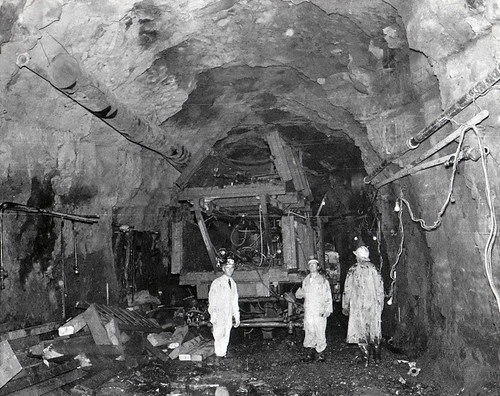
Inside the Molson Collector with the tunnel boring machine nicknamed “Jumbo” by the Atlas Construction Company.
On the South shore, the five mile long Molson collector (aka the Molson Creek Tunnel) was designed to deliver wastewater of Anjou, Maisonneuve and Rosemont into the St. Lawrence. Tunneling had initially started in 1937, but its construction was twice halted, once during WW2 and again during the late 1940s when the city decided to catch up on other sewer projects. It wouldn’t see completion until 1956.
Finally, by 1961 the city had finished construction of a 7km sewer which would replace a significant portion of Riviere St. Pierre flowing through Lachine and Southwest Montreal. It’s this stretch that will be the focus of the next entry in the my Following Riviere St. Pierre series of posts.
Crossposted from www.undermontreal.com
(All b&w photos from the City Archives of Montreal)

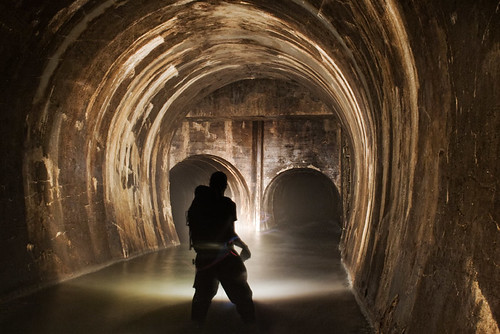
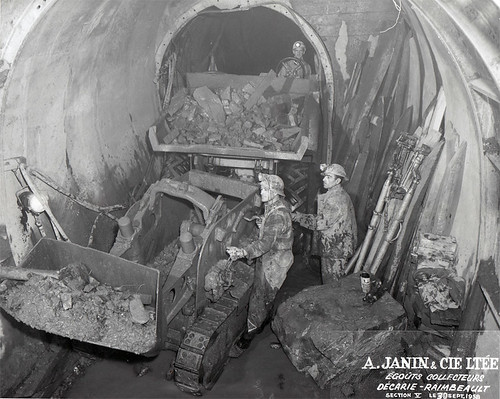
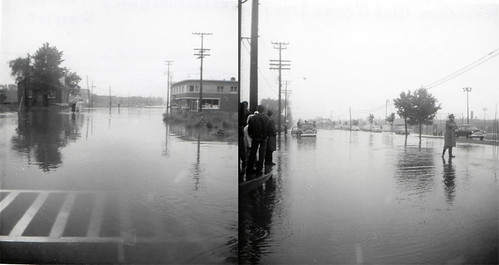
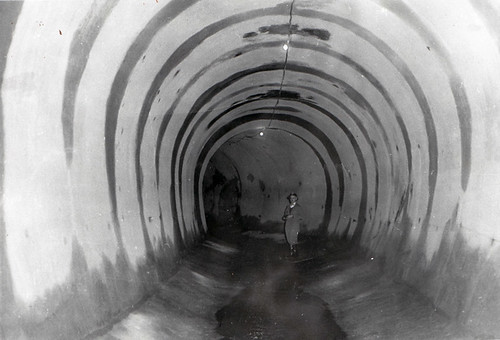
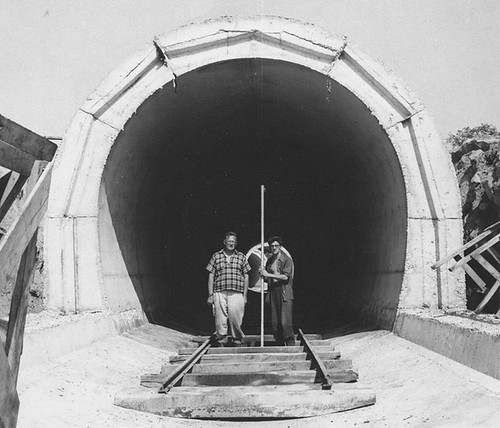
4 comments
Merci.
Il y a une vingtaine d’années, la ville a refait le collecteur qui passe sous le lac du parc Lafontaine après que sa voûte a crevé et que le lac s’y soit complètement vidé.
Un beau jour, je circulais à vélo sur la rue du Parc Lafontaine et il y avait de l’équipement entreposé au milieu de la rue, dont rien que moins qu’un tout petit tunnellier de 2m de diamètre!!!
Really digging your posts Andrew.
As for the Parc Lafontaine collector, I coincidentally picked up a study book over the weekend that goes in great detail about it… old maps, plans, photos, etc.. I picked it up because it discusses in some detail my neighbourhood history (since it goes through Centre Sud) but I think the rest of the book would be more of interest for your studies. Either tonight or sometime this weekend, I’ll get the exact title of the book and contact you through your blog.
A Historic Vertical Tunnel in Montreal.
One the early and largest tunnelling contracts in Montreal was the Canadian Northern Mount Royal Tunnel.
Enough has been written about the tunnel itself and the communities it serves, but, there is another feature that is not quite on the level.
The Mount Royal Tunnel Ventilation Shaft.
http://emdx.org/rail/DeuxMontagnes/Tunnel/rosbif.html
Back before the Metro, where Edouard Monpetit Metro station is now located there was once a nondescript brick building with wooden louvres hidden in the weeds.
My father, who then worked for DEP, now ADT, and I went up there one day, as the brick building was a client of DEP, and, once we arrived at the plain brick cube, he told me that there was a shaft within which led straight down to the Mount Royal Tunnel directly beneath where we stood.
Amazing to a kid of a single-digit age, a shaft without an elevator to the tunnel far below.
I knew the Tunnel carried the trains out to Val Royal where they changed from Electric Locomotives to Steam for our annual trips to Arundel/Huberdeau beyond St Jerome and Wier in the Laurentians.
After we grew up a little we rode on our own on the head end of electric MU cars thru the tunnel from Central out to Saint Eustache, and their Motormen would pointed out the location of the shaft from the bottom end, there being a raised curbing between the double track with a searchlight and railings thereupon.
I understand that during WWII an armed gaurd was posted at the brick building on the surface to prevent sabotage.
( Side Bar. During WWII there were sentries on the bridges on the Aqueduct and concrete sentry boxes shaped like telephone booths were still evident into the sixties.
Where the entrance of the Aqueduct is on LaSalle Blvd. there used to be large vertically hinged gates and turreted concrete towers housing their hoisting mechanisms to close off the water flow from the St Lawrence.
These ornate towers were demolished c. 1967. )
Just before the Electric Locomotives were removed in 1995 I asked an engineer if I could ride the locomotive thru the Tunnel as it was all going to be abandoned in a week or so.
He said “Come on up!”, and off we went from Val Royal, Montreal Bound!
Our train was a ‘deadhead move’, not carrying any passengers and was not to stop at any other stations on the back way into Central.
The Engineer had had a heart attack, was ‘confined’ to suburban train operation, and he was bored, having less than a year until pension.
He like the old electric locomotives, as they reminded him of Steam, spoked wheels and all, from when he was young during the war and had just hired on.
http://www.railpictures.net/viewphoto.php?id=157356&nseq=1
http://www.northeast.railfan.net/images/cn6710.jpg
( Do we miss the past, or our youth? or both? when staring mortality in the face? )
Anyway, we rolled gently along beneath the wire until we entered the Tunnel proper where he said “Did you know these old girls will do 50 mph like a damn?!”
He then grabbed the Controller handle, reminiscent of a Steam Locomotive throttle, and yarded it right out!
Away we went! 50 mph in a flash, and an arc of Catenary!
Because of the rough track and the short-wheel base of the locomotives the cab yawed wildly, rail joins clattering underneath sound magnafied in the confines, headlight beam swinging from wall to wall, pantograph sparking in protest. The rock walls streaking past out the right side.
A Rush beneath the Mountain at twice the permitted speed!
He smiled, then laughed, was young once again, a hotshot Engineer on a train for Toronto and in in great health! revelling in the panacea of speed.
I LOVED it, too! and goaded him to go faster! You only live once!
50 mph on the speedometer inbound to Central Station, Montreal, on a fast passenger, even if timeworn old commuter coaches behind a Great War locomotive.
Just like the old days, when trains were everything!
He said the clean suit white collar Assh–les with more degrees than a thermometer from upstairs at Central HATED the tunnel with it’s walls coated with the grime from brakeshoes and never rode the trains except under duress from their bosses.
The tunnel was too short at 50 mph, so we had to stop and ‘hide’ outside the signal block at Grotto to let our running time catch up.
Time was running out for the equipment from the ‘Teens and Twenties and the Engineer, too.
Sedately into the bowels of Central Station, Montreal, and, shortly after, into history.
Made both our days, and maybe, the locomotive’s too?, if locomotives have ‘life’, that is.?
Briefly young again, all.
Seven, Europe s surge is the consequence of a process integral to the Asian end of Eurasia, not to Europe s singularity. ,